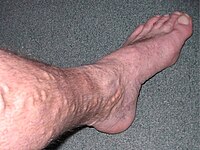
Photo from wikipedia
BACKGROUND Chronic Venous Disease (CVD) has a high prevalence in the western world. Varicose veins (VVs) are the main signs of this disease that is characterized by important pathological vessel… Click to show full abstract
BACKGROUND Chronic Venous Disease (CVD) has a high prevalence in the western world. Varicose veins (VVs) are the main signs of this disease that is characterized by important pathological vessel wall changes. The aim of this study is to correlate the main histopathological abnormalities with related clinical issues of CVD. METHODS A cohort of patients with VVs scheduled for open surgical treatment namely stab avulsion of VVs was recruited. Subsequently, venous tissue from stab avulsion was collected in order to evaluate the following biomarkers: Vascular-Endothelial Growth Factor (VEGF), Protein Gene Product 9.5 (PGP 9.5), Fibronectin (FN) and Matrix Metalloproteinase-9 (MMP-9). The Clinical-Etiology-Anatomy-Pathophysiology (CEAP) criteria were used to classify CVD. RESULTS Fourteen tissue fragments were processed for histological and immunohistochemical studies. Of these, 43 % were from CEAP C2 patients, 36 % from CEAP C3 patients and 21 % from CEAP C4 patients. CEAP Class C2 had few to moderate structures positive to VEGF; occasional structures positive to Fibronectin, numerous structures positive to MMP9, few to moderate structures positive to PGP 9.5. CEAP Class C3 had moderate structures positive to VEGF; few to moderate structures positive to Fibronectin; many structures positive to MMP9; few to moderate structures positive to PGP 9.5. CEAP Class C4 had numerous structures positive to VEGF; numerous structures positive to Fibronectin; abundant structures positive to MMP-9; few structures positive to PGP 9.5. CONCLUSIONS In this study, positive VEGF, FN, and MMP-9 structures were found with increasing trends in relation to the disease staging. VEGF and FN are associated with a progressive increase from C2 to C4. The MMP-9 marker has an important positivity even at early stage of the disease, being higher in CEAP C4 patients. PGP 9.5 decreases in CEAP C4 patients and this is concordant to decreased vein wall innervation.
Journal Title: Annals of vascular surgery
Year Published: 2021
Link to full text (if available)
Share on Social Media: Sign Up to like & get
recommendations!